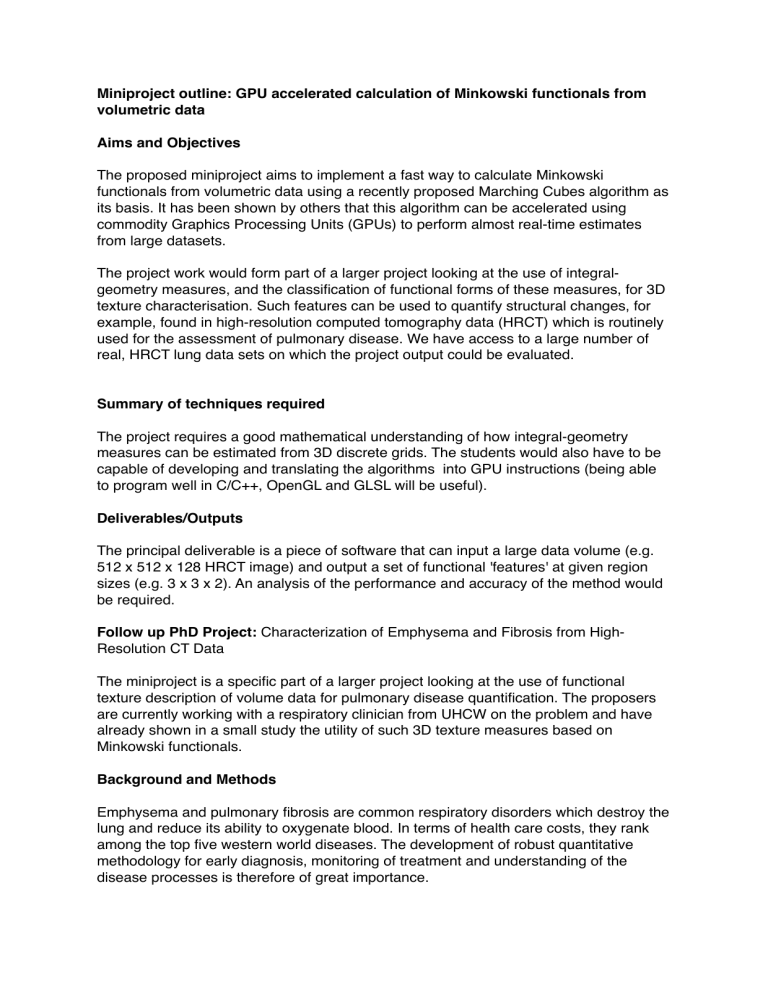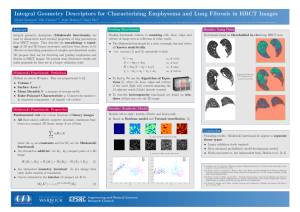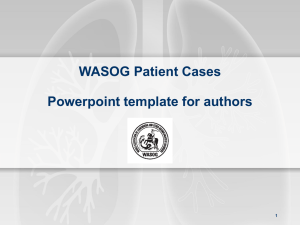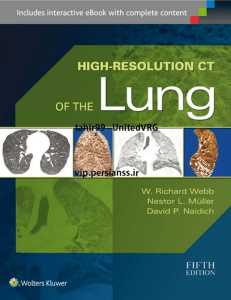Miniproject outline: GPU accelerated calculation of Minkowski functionals from volumetric data

Miniproject outline: GPU accelerated calculation of Minkowski functionals from volumetric data
Aims and Objectives
The proposed miniproject aims to implement a fast way to calculate Minkowski functionals from volumetric data using a recently proposed Marching Cubes algorithm as its basis. It has been shown by others that this algorithm can be accelerated using commodity Graphics Processing Units (GPUs) to perform almost real-time estimates from large datasets.
The project work would form part of a larger project looking at the use of integralgeometry measures, and the classification of functional forms of these measures, for 3D texture characterisation. Such features can be used to quantify structural changes, for example, found in high-resolution computed tomography data (HRCT) which is routinely used for the assessment of pulmonary disease. We have access to a large number of real, HRCT lung data sets on which the project output could be evaluated.
Summary of techniques required
The project requires a good mathematical understanding of how integral-geometry measures can be estimated from 3D discrete grids. The students would also have to be capable of developing and translating the algorithms into GPU instructions (being able to program well in C/C++, OpenGL and GLSL will be useful).
Deliverables/Outputs
The principal deliverable is a piece of software that can input a large data volume (e.g.
512 x 512 x 128 HRCT image) and output a set of functional 'features' at given region sizes (e.g. 3 x 3 x 2). An analysis of the performance and accuracy of the method would be required.
Follow up PhD Project: Characterization of Emphysema and Fibrosis from High-
Resolution CT Data
The miniproject is a specific part of a larger project looking at the use of functional texture description of volume data for pulmonary disease quantification. The proposers are currently working with a respiratory clinician from UHCW on the problem and have already shown in a small study the utility of such 3D texture measures based on
Minkowski functionals.
Background and Methods
Emphysema and pulmonary fibrosis are common respiratory disorders which destroy the lung and reduce its ability to oxygenate blood. In terms of health care costs, they rank among the top five western world diseases. The development of robust quantitative methodology for early diagnosis, monitoring of treatment and understanding of the disease processes is therefore of great importance.
High Resolution Computerized Tomography (HRCT) imaging is routinely used to assess the severity and progress of emphysema, fibrosis and related pulmonary disorders.
While HRCT provides a non-invasive method to detect smaller changes in the structure of lung tissue, current clinical approaches to assessment are limited to calculating a single value reflecting the degree of disease based on some simple criterion, such as lung density. These methods are unable to describe the spatial distribution of emphysema and to link it to the amount of airway disease, which could provide a biomarker for the heterogeneity of chronic obstructive pulmonary disease and related disorders such as fibrosis and interstitial lung disease.
The proposed project will exploit measures of size, shape and connectivity which are known as Minkowski functionals and thus develop a new class of quantitative descriptors of image texture appearance. These provide a way to describe the topology and morphology of the appearance of (diseased) lung tissue as seen in HRCT. The measures can be automatically calculated and compared with templates created by radiological experts thus allowing the patient's lung to be graded by the severity and spatial extent of the disease. The problem is one of pattern classification: the definition of localized measures that transform the 3D image data into texture features which allow a region-by-region classification to known disease states. Successful automatic grading opens the possibility of identifying early stages of the diseases and of quantifying it in a reproducible way. This will have a significant impact on being able to aggressively treat the disease early and support the development of new, more effective drugs to abate its progress.
The project will develop a systematic framework to quantifying structural deformations in the lung due to various respiratory diseases and validate the approach on a large database of patient scans. Part of the validation will be the comparison to other methods and with expert judgement.
More specifically, the project aims are
1. to perform an analysis of the statistical properties of lung tissue descriptors based on localized Minkowski functionals;
2. to develop and implement an automatic classification method for lung scans;
3. to validate the classification method and compare to existing competing approaches;
4. to develop probabilistic models from stochastic geometry that can be fitted to the lung tissue structure of principal disease states.
Beneficiaries
The characterization of spatial morphologies using measures from integral geometry is of immediate current research interest within the areas of spatial statistics and statistical image analysis. The proposed methodology will extend current approaches in a variety of aspects including moving from the more commonly used assumption of a homogeneous medium to a heterogeneous medium consisting of homogeneous regions of differing morphology. Moreover, the approach extends from thresholded, binary images to gray-level images. As a result the characterization will be based on functional descriptors and approaches to classification for functional data will be investigated. This is likely to yield new methods in the area of functional data analysis. New models in
stochastic geometry will be developed to describe the various disease states and fitting methods for these models based on integral geometry descriptors will be an integral part of the development. The characterization of morphology is used in a vast field of application areas ranging from material science to biometry and medicine. The methodology clearly can be extended to many of these applications and thus will benefit academics working in these research areas.
Given the strong interest in both lung pathology and the use of HRCT for screening, monitoring and diagnosis of respiratory disease, as well as our unique access to data, this project is very timely. Its success would have immediate benefits for respiratory medicine in the NHS both for clinicians and patients. It will also provide a tool to the discovery and improvement of drugs.








